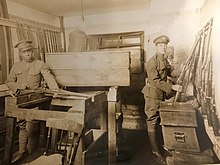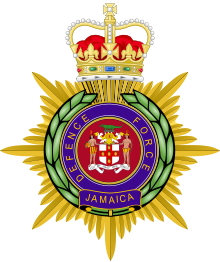District of Columbia National Guard
In 1801, The Organic Act designed District of Columbia as the capital of the United States and put its governance under the control of Congress.
He came into office during a time when strife between two major political parties were threatening to divide a newly developed country.
[10] The war of 1812 would produce an American treasure and one of the most famous veterans of the D.C. National Guard, Francis Scott Key.
The following morning, Key observed the flag still flying above the Fort and was inspired to write the poem that became the lyrics to The Star-Spangled Banner— the national anthem of the United States.
Militia guarded the parade routes, sappers preceded the president-elect, and D.C. Cavalry rode alongside of him, bucking their horses to make it difficult for snipers to take a shot.
When necessary, members of the D.C. National Guard may be deputized as special police, a role the active Army and Air Force cannot perform.
[14] Maryland and Virginia were both slave states at the beginning of the war, surrounding District of Columbia with potential enemy territory.
Militia soldiers served on active duty for up to four years, engaging in combat during the Battle of Manassas and the Valley Campaign.
It is said that he was brusquely ordered from harm's way by an officer, possibly Horatio Wright, although other probably apocryphal stories claim that it was Oliver Wendell Holmes Jr., later Acting Chief Justice of the U.S. Supreme Court.
The Butler Zouaves survived the decline of the militia in the late 1870s and, in 1887, entered the then new National Guard of the District of Columbia as its Fifth Battalion.
In 1917, fearing espionage, D.C. National Guard elements were mobilized 12 days before the U.S. officially entered World War I to protect reservoirs and power plants around District of Columbia Military officials were concerned that too many of the D.C. units were made up of men with foreign roots, thus the job of protecting vital facilities fell to the all-black 1st Separate Infantry, the only unit the military believed could be trusted with this mission.
The soldiers fought in Meuse-Argonne, Lorraine and Alsace, where they were awarded the Croix de Guerre—one of the highest honors bestowed by the French military.
The D.C. National Guard's 121st Engineer Combat Battalion was among the units in the first wave on Omaha beach in Normandy on D-Day.
At the end of World War II, the D.C. National Guard faced the enormous task of restructuring and retraining.
The District of Columbia National Guard played a crucial role in one of the largest gatherings for civil rights in U.S. history.
President John F. Kennedy submitted a compelling federal civil right bill to Congress following the historic march.
As part of the individual or "levied" replacement program, Air National Guard pilots were allowed to volunteer for deployment to Vietnam.
On July 21, 1968, in South Vietnam, Lieutenant Colonel Sherman Flanagan, a D.C. Air Guardsman, crashed his F1-100 Super Sabre, while on his way to a mission and was killed.
[21] On the morning of September 11, 2001, a duty officer from the 113th Wing, D.C. Air National Guard received a call from the U.S. Secret Service with instructions from the White House to scramble F-16s.
After a call with the White House operations center, the 113th Wing commander issued a scramble order to set up a combat air patrol over D.C. and to deter all aircraft within 20 miles with "whatever force is necessary… to keep from hitting a building downtown."
D.C. Air National Guard pilots were prepared to stop any hostile aircraft they encountered by any means necessary, up to and including ramming hijacked airliners.
In the days after September 11, 600 soldiers from the D.C. Army National Guard were mobilized around the city, including the Capitol building.
[citation needed] The D.C. National Guard has deployed more than 1,200 soldiers and airmen to support the Global War on Terrorism.
The D.C. Guard completed over 90 whole-unit deployments, including tours in Iraq, Afghanistan, Guantanamo Bay, Saudi Arabia and stateside missions as part of Operation Noble Eagle.
During the May/June 2020 protests that took place in Washington, D.C., concerning the murder of George Floyd while in Minnesota Police custody, the DCNG served as the hub for 3,000 National Guard members.
The D.C. National Guard is the only U.S. military force empowered to carry out federal functions in a state or, in this case, a district.
It usually is constituted as part of a larger local or Federal effort to prepare for or react to an emerging situation, including National Special Security Events.
Typically, Guard Airmen and Soldiers spend the majority of their careers in the same wing or unit, enabling them to develop long-term relationships, trust, and continuity with their SPP partners.
They must meet the highest standards of military bearing, deportment, dress, and appearance to be eligible for participation in the DCNG Honor Guard program.
It is located at the District of Columbia National Guard headquarters at the D.C. Armory, adjacent to the Stadium-Armory Metro Stop near Robert F. Kennedy Memorial Stadium.












